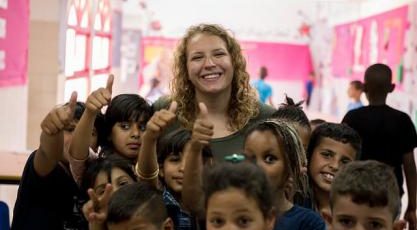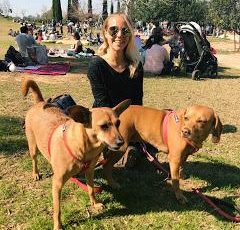Emily Umansky is a 22 year old participant from New York on the MITF Rahat Program. In this blog she talks about her experience teaching Bedouin children English in Rahat.
My name is Emily and I am teaching English in Rahat, a Bedouin city in the northern Negev desert through Masa Israel Teaching Fellows. My co-teacher Anna and I take small groups of 4th, 5th, and 6th graders out of their English classes once a week. We review their classwork and also create our own activities that differ from their normal curriculum.
These children impress me so much – the little English that they know is amazing, considering that they are in elementary school and already learning their third language (after Arabic and Hebrew). Anna and I did not know any Arabic or Hebrew before starting the program, however, which makes the language barrier a great challenge. It can be difficult to explain concepts and get the children to follow directions. Israeli schools also tend to be more chaotic and noisy than American schools, which makes discipline an issue as well, but we we try to keep a balance between focused work and fun. I don’t want our students to fall behind in class because they are spending time with us, but I also want to make English fun and exciting so that they are motivated to study. We focus on encouraging the children to practice speaking with us and to gain confidence with English.
Working in Rahat and getting to know the community has been a wonderful, rich experience. Bedouin culture emphasizes hospitality and our school has been very welcoming. Our students are the most loving students ever. Everyday they leave Anna and I messages on the whiteboard telling us that they love us. They share their snacks and lunches, give us hugs, and constantly ask us about our lives at home. All of the kids in the school, even those that we don’t teach, say hi to us in the hallway and we smile and wave. It warms my heart how excited they are to see us, and I hope that we are living up to their expectations. Bedouin families are very large and the children don’t receive as much attention at home or have access to as many resources as children from America, the Jewish Israeli community, or other more privileged communities typically do. Anna and I think it’s very important to try to make each student feel special and confident.
This inspired us to develop a superhero project; we wanted to give our students an opportunity to imagine themselves as superheroes! I made a slideshow of superhero vocabulary, (strong, brave, fast, fly, etc.) and included pictures of their favorites like Superman and Spiderman. After teaching these words, each student drew her or himself as a superhero on a popsicle stick and then wrote a few sentences describing their powers. It was interesting to see which powers students chose for themselves. Most wrote that they could fly and that they were strong – but while the boys drew themselves with huge muscles, many girls said no when we asked if they were strong. Despite encouraging the girls to think of themselves as strong, some still refused to write it. A lot of our students copied our “Super Emily” and “Super Anna” examples, which was very cute and flattering, but my favorites were when the students got really creative. It makes me so proud when I see how much effort they put into their work, and their original artwork is always so adorable. Now our whole wall is covered in superheroes, making our English corner very colorful and bright.
Some of my favorites include (both 6th graders):
- Super Taqwa: she was the only student to draw herself as invisible! This was the hardest superhero vocab word. She also called herself a super star – so creative, and amazing English skills!
- Super Samer, AKA Super Computer Boy: his grammar is not perfect, but Samer speaks English very well because of online computer games online. You can see his love for the computer come through here. He wants to work for NASA when he grows up!
It’s hard to choose more – they were all adorable! The students got so into the project and every class stayed after the bell because they were working so hard on their artwork.







